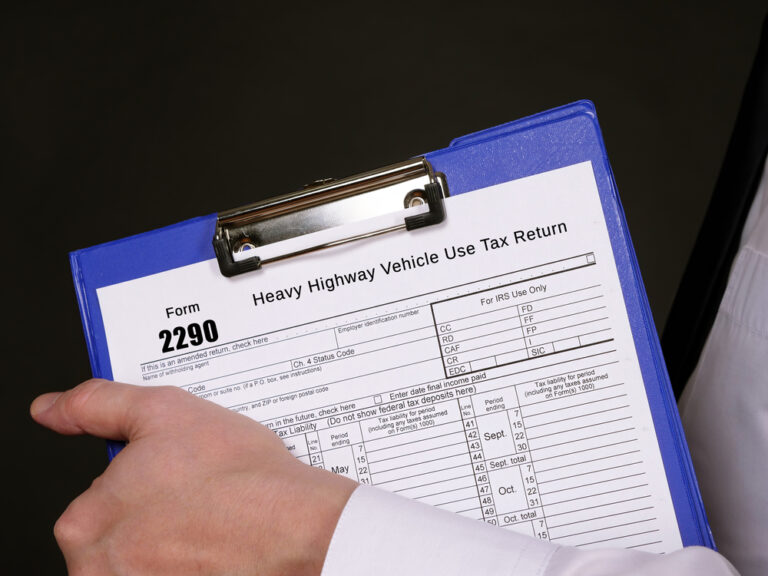When filing the Heavy Vehicle Use Tax (HVUT) Form 2290, there are several common errors that taxpayers might encounter. These mistakes can lead to delays and potential penalties. Understanding and avoiding these errors is crucial for a timely and accurate submission.
Understanding HVUT Filing Requirements
Heavy Vehicle Use Tax (HVUT) Form 2290 is a federal tax form that applies to the use of heavy vehicles operating on public highways. It is a requirement by the Internal Revenue Service (IRS) that must be filed annually by owners of commercial vehicles weighing 55,000 pounds or more. Grasping the intricacies of HVUT Form 2290 requirements is essential for compliance and avoiding complications that may arise from non-adherence.
Key Filing Deadlines for HVUT
Timing is crucial when it comes to HVUT Form 2290 submissions. The standard filing deadline for each tax period is August 31st for vehicles that have been in use since the previous July. However, for those vehicles that are newly acquired or first used in a month other than July, the filing deadline shifts to the end of the month following the month of the vehicle’s first use. For instance, if a vehicle is first utilized in September, the HVUT filing deadline would be October 31st.
To be precise:
Tax period begins July 1st and ends on June 30th of the following year.
Form 2290 must be filed for each month a taxable vehicle is first used on public highways during the tax period.
For vehicles in use at the start of the tax period, file Form 2290 by August 31st.
For vehicles first used after July, file Form 2290 by the last day of the month following the month of first use.
Proactive filing well before the deadline is advisable to allow for any corrections if an error is detected in your submission, thereby avoiding late filing penalties.
Top HVUT Filing Mistakes
It’s not uncommon to talk to individuals who made mistakes when filing their HVUT Form 2290.
Miscalculation of Taxes:
One of the most prevalent errors on the HVUT Form 2290 is the miscalculation of taxes due. The tax amount is determined by the weight of the vehicle and the first month of use during the tax period. Taxpayers should:
Verify the Gross Taxable Weight: Ensure that the Gross Taxable Weight is accurately reported. This is the weight of the vehicle when fully equipped for service, excluding the load.
Determine the Correct Tax Category: Identify the correct tax category for the vehicle based on its weight and usage.
Use IRS Tax Computation Tables: Refer to IRS tax computation tables to calculate the tax accurately. These tables take into account the weight category and the months of usage.
Vehicle Identification Number (VIN) Mistakes
The Vehicle Identification Number (VIN) is a unique code for a motor vehicle. Errors in reporting the VIN can lead to processing delays. Double-check the VIN for accuracy. It should be 17 characters long and contain both numbers and letters, excluding I, O, and Q.
Incorrect Tax Year or First Used Month
Filing with the wrong tax period or incorrect first used month can cause problems. Select the appropriate tax year for which you are filing, and accurately report the month when the vehicle was first used on public highways during that period.
Filing Late Without Reason
Filing after the due date without a reasonable cause is a mistake that could result in penalties. The usual deadline is August 31st for vehicles in use since July, or the last day of the month following the month of first use for new or newly acquired vehicles.
EIN Issues
A valid Employer Identification Number (EIN) is mandatory on the Form 2290. Using a Social Security Number instead of an EIN is a common error. If you do not have an EIN, apply for one well in advance of the filing deadline. It can take up to two weeks for a new EIN to be active in the IRS system.
Forgetting to Sign the Form
An unsigned HVUT Form 2290 will not be processed by the IRS. Ensure that the form is signed by the authorized individual. If filing through an agent or third party, a valid Power of Attorney may be required.
Not Using Authorized E-file Providers
While Form 2290 can be filed on paper, the IRS encourages e-filing, especially for fleets with 25 or more vehicles. Using an unauthorized e-file provider can lead to insecure transmission of information or incorrect filings. Use only IRS-approved e-file providers to ensure accuracy and security.
By paying close attention to these details and staying diligent in the process, you can ensure your HVUT Form 2290 is submitted correctly, avoiding unnecessary complications and penalties.
Detailed Breakdown of HVUT Requirements
The Taxable Gross Weight of a vehicle determines the tax rate for HVUT. The taxable gross weight includes the actual unloaded weight of the vehicle, plus the weight of any trailers and maximum load customarily carried.
Tax Computation Tables provided by the IRS should be used to determine the tax based on the taxable gross weight and the number of months the vehicle is in use.
The Vehicle Identification Number (VIN) must be correctly reported. A 17-character combination unique to every vehicle, the VIN is crucial for the IRS to track your filing and tax payment history.
The accurate tax year and the first month the vehicle was in service must be indicated on the form. Incorrect reporting can lead to processing errors and potential penalties.
E-file for Efficiency
The IRS recommends e-filing for submitting Form 2290, especially for fleet owners with 25 or more vehicles, due to its efficiency and speed. It is important to use only IRS-authorized e-file providers, as this ensures secure and accurate filing. You can find a list of IRS-approved e-file providers on the official IRS website.
Understanding and adhering to the HVUT Form 2290 filing requirements is a legal obligation for heavy vehicle operators and is key to maintaining compliance with federal regulations. Keep informed about tax computation, weigh your vehicles accurately, remember the critical filing dates, and use secure e-filing options to ensure a smooth and penalty-free submission process.

The Cost of Missing the HVUT Filing Deadline
Late filing can result in a series of penalties that escalate over time. According to the Internal Revenue Service:
Failure to file HVUT Form 2290 by the due date may result in a penalty equal to 4.5% of the total tax due, accruing on a monthly basis for up to five months.
Late payment of the tax due can incur an additional penalty of 0.5% of the tax owed, plus additional interest charges of 0.54% per month.
Consequences:
Accumulating penalties for filing up to five months late.
Additional penalties and interest for late payment of tax due.
E-filing as a Preventative Measure
E-filing is highly advised by the IRS for its expediency and accuracy, and it’s specifically recommended for fleet owners with 25 or more vehicles. By e-filing with an IRS-authorized provider, you get:
Instant Submission Confirmation: Proof of filing is immediate, providing peace of mind and evidence to avoid penalties.
Rapid Processing: E-filing speeds up the processing time, allowing for faster acknowledgment from the IRS.
Ease of Correction: If errors are found, e-filing allows for quicker amendments and re-filings, minimizing the penalty window.
Meeting the HVUT filing deadline is a crucial element of fiscal responsibility for heavy vehicle operators. By understanding and respecting the imposed deadlines, harnessing organizational tools and technology, and opting for e-filing, you can effectively navigate the HVUT filing process and avoid unnecessary penalties. Remember, preparation and attentiveness to the calendar are your best defenses against the stresses and fines associated with tardy HVUT form submissions.
Why Use ExpressTruckTax for HVUT Filing
Choosing the right platform for your Heavy Vehicle Use Tax (HVUT) filing is crucial to ensure compliance, accuracy, and efficiency. ExpressTruckTax specializes in assisting truckers and fleet operators with their HVUT Form 2290 electronic submissions:
User-Friendly Interface and Simplified Process
Intuitive Dashboard: ExpressTruckTax offers a dashboard that is easy to navigate, even for those who are new to HVUT filing. Users can quickly access their filing history, manage their account details, and start new HVUT filings with minimal learning curve.
Step-by-Step Guidance: The platform provides guided steps to help users fill out their HVUT Form 2290 correctly, reducing the risk of errors that could arise from misunderstanding form requirements.
Built-in Tax Calculator: ExpressTruckTax includes a tax calculator that automatically determines the tax amount based on the taxable gross weight and the first used month without the need to manually reference IRS tax tables. This ensures precise calculations and eliminates potential arithmetic errors.
Compliance Support and Regulatory Updates
IRS-Approved E-filing: As an IRS-authorized electronic filing provider, ExpressTruckTax ensures that the submissions are in full compliance with current IRS regulations and standards, offering users confidence in their filing.
Tax Form Reviews: Before submission, forms undergo an internal review process to catch common mistakes and inconsistencies, which can help users avoid unnecessary delays or penalties associated with incorrect filings.
Enhanced Data Security and Management
Secure Data Transmission: With advanced encryption technology, ExpressTruckTax offers robust security for sensitive information, such as EINs and VINs, protecting users against data breaches and fraud.
Data Retention and Retrieval: ExpressTruckTax stores previously submitted forms and tax records securely online, making it simple for users to retrieve past filings for reference or audits, and to copy details for the new tax year, saving time and reducing manual data entry.
Additional Convenience Factors
Multiple Filing Options: Whether you are filing for a single vehicle or managing a fleet, ExpressTruckTax allows for both individual and bulk submissions, catering to diverse filing needs.
Instant IRS Stamped Schedule 1: Upon successful filing and IRS acceptance, users receive their stamped Schedule 1 instantly via email. This official document serves as proof of tax payment, and ExpressTruckTax ensures that it is quickly accessible.
Customer Support: ExpressTruckTax provides extensive customer support via phone, email, and live chat. Their dedicated tax specialists offer assistance and answer questions related to HVUT filings, helping users through every step of the process.
Don’t let manual HVUT filing errors cost you time and money. Take advantage of ExpressTruckTax’s expertise, secure platform, and exceptional customer support to make your filing process as smooth as possible.

